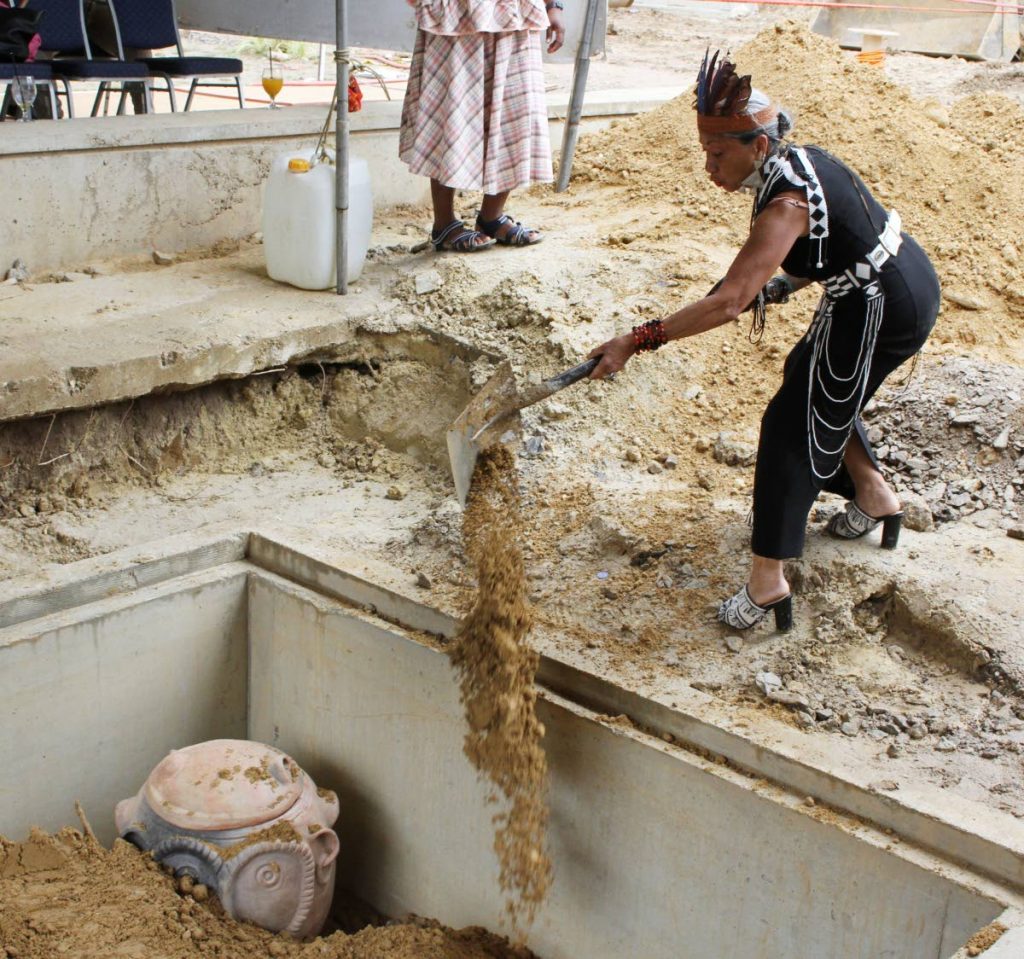60 First Peoples remains laid to rest at Red House

After six long years the remains of at least 60 of the country’s First Peoples were returned to their resting place at the Red House.
There were tears and solemn faces yesterday during the reinterment ceremony of indigenous human remains which were removed during the restoration of the Red House in 2013.
Shamans and representatives of Amerindians from Suriname, Guyana, Guatemala, Venezuela, Dominica, Canada, and the US participated in the ceremony. They called to the Great Spirits to give peace and rest to the ancestors, and that they continue to guide the decedents through dreams and visions. The ceremony also included songs and the use of tobacco, incense, maracas (chac-chacs), and consecrated water.
The bones were laid out in boxes around the edges of the tomb and Anesta Jagendorst, a shaman from Suriname, blessed the bones. The boxes were emptied and the bones laid out among clay containers on the floor of the concrete tomb by members of the First Peoples.
As a backhoe covered the bones in a layer of dirt, Jagendorst experienced a “manifestation.” She repeatedly shouted “Thank you!” and “This is my day!” as she slipped to the muddy ground and vacillated between seeming unconsciousness and vigour. She was surrounded by others, including TT’s new Carib Queen Nona Aquan, who tried to restore and calm her.
In his address, First Peoples chief Ricardo Bharath-Hernandez said while people may see the discovery of the remains and artifacts as an accident, to the indigenous people of TT it was seen as ancestors communicating to them. “Some may look at this Ceremony as something that does not matter, neither important nor significant. But just as most of us treat our dead with respect, and use the appropriate rituals in their own tradition, we feel very strongly that the remains of our ancestors should be respected and treated likewise...
“The reinterment of these human remains has provided a sense of peace, shelter and security for the First Peoples. At the same time it has opened a door of opportunity for our challenges and needs to be expressed.”

He said he is reconsidering the First Peoples’ Day of Recognition as a one-off holiday and instead calling for a permanent holiday on October 14. He said although his people recognised it, members were unable to celebrate because they have to attend work and school. He said the national community forgot about the day and its meaning while others were not even aware there was such a day.
At one point Bharath-Hernandez had trouble finishing his speech and requested PNM PRO, and member of the First Peoples, Laurel Lezama-Lee Sing, continue reading on his behalf. She said other challenges included Government granting land in Arima to the First Peoples rather than giving them a lease, the creation of an independent seat in some local government councils for members of the indigenous community, and reparations.
She said addressing above concerns would be considered a form of reparation. He called for the revival of the Reparations Committee and government’s assistance in establishing a Heritage Village to empower the indigenous community to preserve and build on their cultural traditions.
On the topic of the Christopher Colombus statue, she said Bharath-Hernandez did not understand how its removal would contribute to the upliftment and development of the First Peoples. “While he stands there someone can always point to him and recall the atrocities committed against the First Peoples as a result of the encounter. When you erase the landscape there is nothing there to remind people of the demise of our First Peoples. So as a result people, over time, will forget because of omission.”

However she said if the removal was a catalyst for the promised monument to be erected over the remains at the Red House, they would support the statue’s removal. She unveiled a miniature of the proposed monument called The Blood of the First Peoples. “It is a tribute in recognition of the contribution and sacrifices of the First Peoples who built the foundation of out homeland Cairi and fought to defend it against colonisers.”
Agriculture Minister Clarence Rambharat also gave the First Peoples the new national flower, the Double Chaconia, to be planted on their land in Arima. He said First Peoples around the world had been fighting for equality and their rights, and the next stage was preeminence. “I hope that we accelerate and move to the discussion of preeminence, about how we as the second people treat and deal with the first Peoples.”

PHOTO BY ANGELO MARCELLE
Minister of Community Development, Culture and the Arts Dr Nyan Gadsby-Dolly said the community’s rights were clearly stated in the UN Declaration on the Rights of Indigenous Peoples which as adopted by TT in 2007. “As such, respecting and honouring the traditions of our indigenous peoples is central to protecting and preserving our heritage as a people.”
Also in attendance was Speaker of the House of Representatives Brigid Annisette-George, Inter Religious Organization President Canon Knolly Clarke, Port of Spain Mayor Joel Martinez, Congress of the People political leader Carolyn Seepersad-Bachan, and Senate Vice President Nigel De Freitas.

Comments
"60 First Peoples remains laid to rest at Red House"